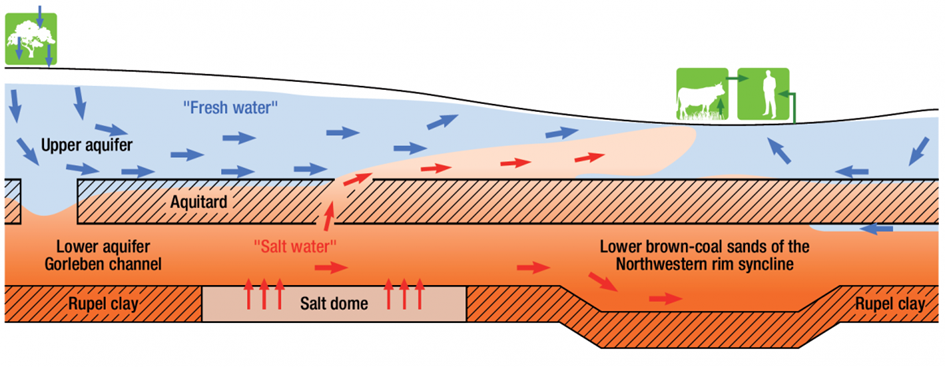In the first step the smart Kd-concept was developed for a typical sedimentary system in Northern Germany. The Gorleben area was chosen due to the availability of a comprehensive data set. Generally, the system comprises three hydrogeological units, representing the upper aquifer, an underlying aquitard, and the lower aquifer (Fig. 1). The lower aquifer is characterized by high salt concentrations in the groundwater, resulting from the contact to the cap rock of the salt dome and leaching of salt. The upper aquifer is characterized by low salt concentrations (freshwater conditions).
The geochemical situation in the upper aquifer was chosen to develop a simple testcase for verification calculations. Comparative simulations with d3f++ and PHAST (Parkhurst et al, 2010) were performed to test the smart Kd-concept against the full geochemical model (Concept verification).
Based on the schematic cross section shown in Fig. 1, a 2D model was developed and the smart Kd-concept was used to describe long-term chemical changes in large model areas including their impact on radionuclide sorption (Large-scale application).
Fig. 1: Schematic north-south striking cross section of the hydrogeological system at the Gorleben reference site (modified from Klinge et al., 2007; published with permission from BGR), lateral extension app. 16 km, horizontal extension up to 480 m.
Currently, a second representative sedimentary system is set-up, where the key selection criterion was the occurrence of spatially and temporally changing redox conditions and the availability of reliable redox data from field explorations (Fig. 2). The selected site denoted as Bourtanger Moor aquifer system is located in Northwestern Germany (Emsland) near the small town Haren (Houben et al., 2001).
Fig. 2: Schematic hydrogeological cross-section of the Bourtanger Moor aquifer system near Haren (Houben et al., 2001).
The system is characterized by sharp redox front in approximately 11 m depth, which is mainly caused by a strong agricultural nitrate input oxidizing the authigenic pyrite minerals as the most relevant reactive and reducing constituent of the quaternary sediments (Houben et al., 2017). The system is well described with respect to mineralogy, groundwater chemistry (including redox pairs) and hydrogeological conditions. Using the information and data from this site an approach for redox reactions is currently developed to be implemented in the existing concept.
Contact: Dr. Ulrich Noseck, Anne Gehrke
References:
Klinge, H., Boehme, J., Grissemann, C., Houben, G., Ludwig, R.-R., Rübel, A., Schelkes, K., Schildknecht, F., Suckow, A., Standortbeschreibung Gorleben, Teil 1: Die Hydrogeologie des Deckgebirges des Salzstocks Gorleben, Geol. Jb., C 71 (2007) 199 p.
Houben, G.; Houben, G.J., Martiny, A., Bäßler, N., Langguth, H.-R., Plüger, W.L., Assessing the reactive transport of inorganic pollutants in groundwater of the Bourtanger Moor area (NW Germany). Environ. Geol. 41 (3/4), (2001) 480 - 488 p.
Houben, G.J., Sitnikova, N.A., Post, E.A.: Terrestrial sedimentary pyrites as a potential source of trace metal release to groundwater e A case study from the Emsland, Germany. Applied Geochemistry 76 (2017) 99-111 p.
Parkhurst, D.L., Kipp, K.L., and Charlton, S.R., 2010, PHAST Version 2 - A program for simulating groundwater flow, solute transport, and multicomponent geochemical reactions: U.S. Geological Survey Techniques and Methods 6–A35, 235 p.

